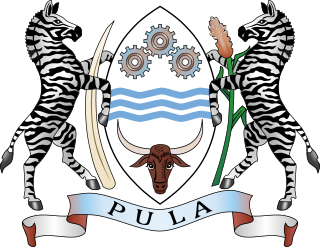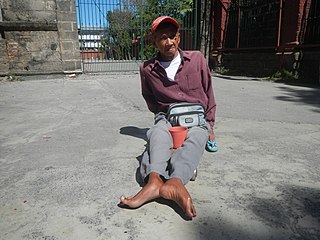Related Research Articles

The International Convention on the Protection of the Rights of All Migrant Workers and Members of Their Families is a United Nations multilateral treaty governing the protection of migrant workers and families. Signed on 18 December 1990, it entered into force on 1 July 2003 after the threshold of 20 ratifying States was reached in March 2003. The Committee on Migrant Workers (CMW) monitors implementation of the convention, and is one of the seven UN-linked human rights treaty bodies. The convention applies as of October 2022 in 58 countries.

Human rights in Eritrea are viewed, as of the 2020s, by non-governmental organisations (NGOs) such as Human Rights Watch as among the worst in the world, particularly with regards to freedom of the press. Eritrea is a one-party state in which national legislative elections have been repeatedly postponed, the judiciary is weak, and constitutional provisions protecting individual freedom have yet to be fully implemented. Some Western countries, particularly the United States, accuse the Government of Eritrea of arbitrary arrest and detentions and of detaining an unknown number of people without charge for their political activism. Additionally Eritrean citizens, both men and women, are forcibly conscripted into the military with an indefinite length of service and used as forced labour.

The U.S. Department of State's Country Report on Human Rights Practices for São Tomé and Príncipe states that the government generally respects the human rights of its citizens, despite problems in a few areas.

Human rights in Somalia throughout the late 20th-century and early 21st-century were considered dire, but have gradually improved over the following years. Human rights are guaranteed in the Federal Constitution, which was adopted in August 2012. They fall under the Ministry of Human Rights established in August 2013. The central authorities concurrently inaugurated a National Human Rights Day, endorsed an official Human Rights Roadmap, and completed Somalia's first National Gender Policy.

Human rights in Chad have been described as "poor"; for example, Freedom House has designated the country as "Not Free." Chad received a score of 7 for political rights and 6 for civil liberties.

According to the Republic of Niger's Constitution of 1999, most human rights, as defined by the Universal Declaration of Human Rights, are upheld and protected. Despite these protections, concerns of both domestic and international human rights organizations have been raised over the behavior of the government, military, police forces, and over the continuation of traditional practices which contravene the 1999 constitution. Under French colonial rule (1900–1960) and from independence until 1992, citizens of Niger had few political rights, and lived under arbitrary government power. Although the situation has improved since the return to civilian rule, criticisms remain over the state of human rights in the country.

The Convention on the Rights of Persons with Disabilities is an international human rights treaty of the United Nations intended to protect the rights and dignity of persons with disabilities. Parties to the convention are required to promote, protect, and ensure the full enjoyment of human rights by persons with disabilities and ensure that persons with disabilities enjoy full equality under the law. The Convention serves as a major catalyst in the global disability rights movement enabling a shift from viewing persons with disabilities as objects of charity, medical treatment and social protection towards viewing them as full and equal members of society, with human rights. The convention was the first U.N. human rights treaty of the twenty-first century.

Human rights in Botswana are protected under the constitution. The 2009 Human Rights Report by the United States Department of State noted that in general the government of Botswana has respected the rights of its citizens.

Human rights in Cape Verde are addressed under the national constitution.
Human rights in South Africa are protected under the constitution. The 1998 Human Rights report by Myles Nadioo noted that the government generally respected the rights of the citizens; however, there were concerns over the use of force by law enforcement, legal proceedings and discrimination. The Human Rights Commission is mandated by the South African Constitution and the Human Rights Commission Act of 1994, to monitor, both pro-actively and by way of complaints brought before it, violations of human rights and seeking redress for such violations. It also has an educational role.
The Committee on the Rights of Persons with Disabilities is a United Nations body of 18 experts that meets two times a year in Geneva to consider the reports submitted by 164 UN member states on their compliance with the Convention on the Rights of Persons with Disabilities (CRPD), and to examine individual petitions concerning 94 States Parties to the Optional Protocol.
The issue of human rights in Tanzania, a nation with a 2012 population of 44,928,923, is complex. In its 2013 Freedom in the World report, Freedom House declared the country "Partly Free".
Social engagement refers to one's degree of participation in a community or society.
The incidence of disability in Costa Rica is about 10.5% of the population. The country is a party to the United Nations Convention on the Rights of Persons with Disabilities since 2008.
There are 26.8 million people with disabilities in India according to the 2011 census of India, while other sources have offered higher estimates. India is a party to the United Nations Convention on the Rights of Persons with Disabilities. Legislation that affects people with disabilities in India includes the Rights of Persons with Disabilities Act, 2016, the Mental Health Care Act, 2017, the National Trust Act, 1999, and the Rehabilitation Council of India Act, 1992. People with disabilities in India are faced with negative social attitudes in the wider population.
There are an estimated 16 million people with disabilities in Bangladesh, or 10% of the country's population. In 2004, the prevalence of disability was about 6% among those below the age of 18 and about 14% among those above that age. People in Bangladesh living with disabilities are entitled to government support, but programs have been limited in scope and restricted to urban areas, and the question of disability has not been integrated into general development programs. In response, NGOs such as the Centre for Disability in Development have moved to provide assistance to people with disabilities.

People with disability in Luxembourg have some legal protections from discrimination and their needs can be provided through various government policies. Students with disabilities have a fairly good rate of completing school compared to peers without a disability. Luxembourg signed onto the Convention on the Rights of Persons with Disabilities on March 30, 2007. Much of the country is accessible, however, there are no legal provisions for reasonable accommodations.
Disability in Mexico affects a substantial minority of the country's population, though estimates of the prevalence vary significantly. According to the 2000 Mexican census, there were 1,795,000 people with disabilities in the country, or 1.8% of the population. However, a 2005 brief by the Mexican government for a World Health Organization summit argued the methodology used for the census was flawed and led to under-reporting. A 2017 research paper cites a higher estimate of 6.0%, noting the prevalence was greater at 7.1% among Mexicans of indigenous background.
Estimates of the prevalence of disability in Egypt have ranged from 1.8% to 11%. Egypt ratified the United Nations Convention on the Rights of Persons with Disabilities on 10 April 2008. The Egyptian constitution of 2014 guarantees a range of rights for people with disabilities, and Egypt passed legislation entitled the Law on the Rights of Persons with Disabilities in February 2018.

Climate change disproportionately effects individuals with disabilities, both directly and indirectly. Individuals with disabilities are more likely to experience the effects of climate change on humans more acutely compared to those without disabilities. Typically, disabled people are the most likely to be negatively affected by any form of emergency, whether it be an immediate emergency like a flood or tornado or a gradual emergency like rising sea levels, due to a lack of access to emergency resources and the difficulties imposed by limited mobility. Disabled people are also more adversely affected by climate change because a disproportionate number of disabled people live in poverty, and people living in poverty are inherently more at risk due to climate change. Despite this, and despite the fact that disabled people make up more than 15% of the global population, they have had minimal input and involvement in the decision-making process surrounding responses to climate change. A 2022 study by the Disability-Inclusive Climate Action Research Programme revealed that only 37 of 192 State Parties to the Paris Agreement currently refer to persons with disabilities in their nationally determined contributions, while only 46 State Parties refer to persons with disabilities in their domestic climate adaptation policies.
References
- 1 2 Adioetomo, Sri Moertiningsih; et al. "Persons with Disabilities in Indonesia: Empirical Facts and Implications for Social Protection Policies" (PDF). The National Team for the Acceleration of Poverty Reduction. Retrieved 21 November 2015.
- ↑ "UN Treaty Collection: parties to the Convention on the Rights of Persons with Disabilities: List of parties". United Nations. 2012-03-21. Archived from the original on 2012-08-19. Retrieved 2015-11-20.